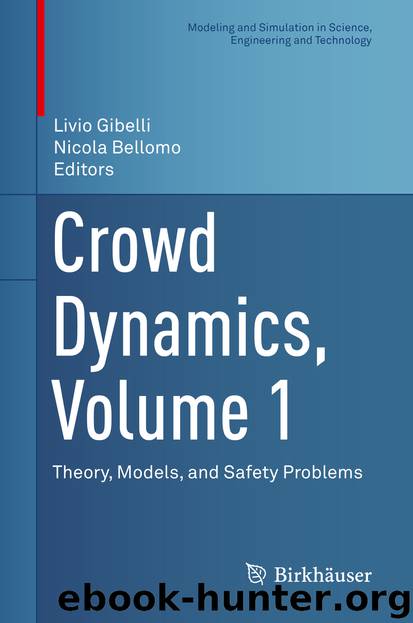Crowd Dynamics, Volume 1 by Livio Gibelli & Nicola Bellomo

Author:Livio Gibelli & Nicola Bellomo
Language: eng
Format: epub
ISBN: 9783030051297
Publisher: Springer International Publishing
(3)
Second-order models close system (1), and (2) by adding a CL as third constitutive equation. The most celebrated second-order model is the Aw, Rascle [8], and Zhang [48] model (ARZ). Away from the vacuum ρ = 0, ARZ writes
(4)
where y = (v + p(ρ)) ρ is called generalized momentum. The “pressure” function plays the role of an anticipation factor, taking into account agents’ reactions to the traffic in front of them.
From the modeling point of view, the main drawback of LWR is the fact that agents adjust instantaneously their velocities according to the density they are experiencing (which implies infinite acceleration) and take into account the slightest change in the density. This behavior contradicts the empirical observations. Also, experimental data show that the fundamental diagram (ρ, f) is given by a cloud of points rather than being the support of a map , see [20, Figure 1.1] or [14, Figure 3.1]. ARZ can be interpreted as a generalization of LWR, possessing a family of fundamental diagram curves, rather than a single one. For this reason ARZ avoids the drawbacks of LWR listed above. Moreover, the empirical tests in [26] show that in many cases, ARZ is significantly more accurate than LWR.
From the mathematical point of view, however, the analysis of ARZ requires a higher degree of technicalities because system (4) degenerates into just one equation at the vacuum. As observed in [31], taking initial data away from the vacuum does not forbid the emergence of vacuum in the solutions; in this case the solutions do not depend continuously on the initial data and experience a sudden increase of the total variation as the vacuum appears.
Goatin [30] bypasses these drawbacks of LWR and ARZ by coupling the two models. The resulting phase transition model (PT) describes the free-flow phase Ω f with LWR and the congested phase Ω c with ARZ. This PT model has been generalized in [10–12, 24].
An underlying assumption of all the models considered above (LWR, ARZ, PT) is that agents move in a homogeneous environment. However, in real life, agents typically move in inhomogeneous spaces characterized by “obstacles” that hinder the density flow, such as bottlenecks and traffic lights. The effect of such obstacles can be represented by introducing point constraints on the density flow
Download
This site does not store any files on its server. We only index and link to content provided by other sites. Please contact the content providers to delete copyright contents if any and email us, we'll remove relevant links or contents immediately.
Algorithms of the Intelligent Web by Haralambos Marmanis;Dmitry Babenko(8522)
Test-Driven Development with Java by Alan Mellor(7403)
Data Augmentation with Python by Duc Haba(7298)
Principles of Data Fabric by Sonia Mezzetta(7046)
Learn Blender Simulations the Right Way by Stephen Pearson(6983)
Microservices with Spring Boot 3 and Spring Cloud by Magnus Larsson(6802)
RPA Solution Architect's Handbook by Sachin Sahgal(6215)
Hadoop in Practice by Alex Holmes(6031)
The Infinite Retina by Robert Scoble Irena Cronin(5914)
Jquery UI in Action : Master the concepts Of Jquery UI: A Step By Step Approach by ANMOL GOYAL(5873)
Big Data Analysis with Python by Ivan Marin(5720)
Life 3.0: Being Human in the Age of Artificial Intelligence by Tegmark Max(5402)
Pretrain Vision and Large Language Models in Python by Emily Webber(4682)
Infrastructure as Code for Beginners by Russ McKendrick(4462)
WordPress Plugin Development Cookbook by Yannick Lefebvre(4194)
Functional Programming in JavaScript by Mantyla Dan(4124)
The Age of Surveillance Capitalism by Shoshana Zuboff(4116)
Embracing Microservices Design by Ovais Mehboob Ahmed Khan Nabil Siddiqui and Timothy Oleson(3981)
Applied Machine Learning for Healthcare and Life Sciences Using AWS by Ujjwal Ratan(3958)
